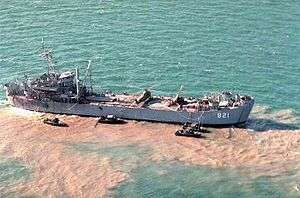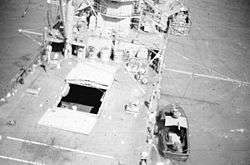USS Harnett County (LST-821)
 USS Harnett County (AGP-821) in South Vietnamese waters, c. 1967–1970. Atop her flight deck is a Sikorsky H-34 "Choctaw" helicopter (left) and a Navy Helicopter Attack (Light) Squadron Three (HAL-3) "Seawolf" UH-1B Huey gunship. | |
| History | |
|---|---|
| Name: | USS LST-821 |
| Builder: | Missouri Valley Bridge & Iron Company, Evansville, Indiana |
| Laid down: | 19 September 1944 |
| Launched: | 27 October 1944 |
| Commissioned: | 14 November 1944 |
| Decommissioned: | March 1946 |
| Renamed: | USS Harnett County (LST-821), 1 July 1955 |
| Recommissioned: | 20 August 1966 |
| Decommissioned: | 12 October 1970 |
| Reclassified: | AGP-821, 1970 |
| Honors and awards: |
|
| Fate: | Transferred to South Vietnam, 12 October 1970 |
| Name: | RVNS My Tho (HQ-800) |
| Acquired: | 12 October 1970 |
| Fate: | Transferred to the Philippines, 5 April 1976 |
| Name: | BRP Sierra Madre (LT-57) |
| Acquired: | 5 April 1976 |
| Decommissioned: | 1999 |
| Fate: | Deliberately grounded in 1999; turned into an advance outpost at Second Thomas Shoal (South China Sea)[1]9°47′42″N 115°51′22″E / 9.795°N 115.856°ECoordinates: 9°47′42″N 115°51′22″E / 9.795°N 115.856°E |
| Status: | Decommissioned (2000), used as an outpost as of 2014 |
| General characteristics | |
| Class and type: | LST-542-class tank landing ship |
| Displacement: |
|
| Length: | 328 ft (100 m) |
| Beam: | 50 ft (15 m) |
| Draft: |
|
| Propulsion: | 2 × General Motors 12-567 diesel engines, two shafts, twin rudders |
| Speed: | 12 knots (22 km/h; 14 mph) |
| Boats & landing craft carried: | Two LCVPs |
| Troops: | 16 officers, 147 enlisted men |
| Complement: | 7 officers, 104 enlisted men |
| Armament: |
|
The USS LST-821, renamed the USS Harnett County (LST-821), USS Harnett County (AGP-821), My Tho HQ-800 (Vietnam) and finally LT 57 Sierra Madre (Philippine Navy) was an LST-542-class tank landing ship built for the United States Navy during World War II. She was named for Harnett County, North Carolina and was the only U.S. Naval vessel to bear the name. She served the US Navy in World War II and the Vietnam War. She was transferred to South Vietnam's Republic of Vietnam Navy, which named her RVNS My Tho (HQ-800).
After the Vietnam War, Harnett County was transferred to the Philippine Navy, which named her BRP Sierra Madre (LT-57). In 1999 the Philippine government deliberately had her run aground on Second Thomas Shoal in the Spratly Islands to serve as an outpost of the Philippine Marine Corps to assert Philippine sovereignty in the country's dispute with China over the ownership of the Spratly Islands. She still serves that function.
US Service history
USS LST-821 was laid down on 19 September 1944 at Evansville, Indiana by the Missouri Valley Bridge & Iron Company; launched on 27 October 1944; sponsored by Mrs. Hugh Robertson, Sr.; and commissioned on 14 November 1944 with Lieutenant C. J. Rudine, USNR, in command.
During World War II, LST-821 was assigned to the Asiatic-Pacific theater and participated in the assault and occupation of Okinawa Gunto from April through June 1945. Following the War, she performed occupation duty in the Far East until early December 1945. LST-821 returned to the United States and was decommissioned in March 1946 and assigned to the Pacific Reserve Fleet. On 1 July 1955 all remaining LSTs were given names of U.S. counties; LST-821 was named USS Harnett County (LST-821).
Recommissioned on 20 August 1966, Harnett County saw extensive service in the Vietnam War, participating in the following campaigns:
- The Vietnamese Counteroffensive – Phase II (12 January to 31 May 1967)
- The Vietnamese Counteroffensive – Phase III (1 June to 12 July 1967 and 17 August 1967 to 29 January 1968)
- The Tet Counteroffensive (30 January to 27 February 1968)
- The Vietnamese Counteroffensive – Phase IV (9 April to 30 June 1968)
- The Vietnamese Counteroffensive – Phase V (1 July to 1 November 1968)
- The Vietnamese Counteroffensive – Phase VI (2 to 4 November 1968 and 8 December 1968 to 22 February 1969)
- The Tet/69 Counteroffensive (23 February to 7 May 1969)
- Vietnam Summer-Fall 1969 (4 August to 31 October 1969)
- Vietnam Winter-Spring 1970 (1 November 1969 to 22 January 1970 and 17 February to 30 April 1970)
- The Sanctuary Counteroffensive (1 May to 30 June 1970)
- The Vietnamese Counteroffensive – Phase VII (1 to 21 July 1970)
She was redesignated a Patrol Craft Tender, USS Harnett County (AGP-821) in the spring of 1970, but then was decommissioned 12 October 1970 at Guam.
LST-821 earned one battle star for World War II service. Additionally, Harnett County earned nine battle stars, two awards of the Presidential Unit Citation, and three awards of the Navy Unit Commendation for the Vietnam War.
RVN and Philippine service history
The US transferred Harnett County to the Republic of South Vietnam under the Security Assistance Program on 12 October 1970 and renamed RVNS My Tho (HQ-800). My Tho was one of the flotilla of thirty-five Republic of Vietnam Navy ships that sailed for Subic Bay after the fall of Saigon in April 1975.
She was transferred to the Philippines on 5 April 1976, which named her BRP Sierra Madre (LT-57).
Involvement in the Spratley Islands dispute
In 1999, the Philippine Navy intentionally ran her aground on the Ayungin Shoal in order to maintain the Philippine's territorial claim in the area. Since then a detachment of Filipino marines have been stationed on board the Sierra Madre to provide a continual military presence at the site. The Chinese coast guard frequently patrols the area and attempts to prevent the resupply of these Filipino marines. In 2013, the New York Times reported on the life of the handful of marines stationed on board the Sierra Madre at Second Thomas Shoal and the vessel's role in the geopolitics of the South China Sea. One may infer from the article that Sierra Madre will never sail again, however she has gained importance due to her role as an outpost in the Spratly Islands dispute.[2] The List of ships of the Philippine Navy no longer carries her as being in commission, however she has not officially been decommissioned either.
On 11 March 2014, the Philippine government protested to the Chinese chargé d'affaires in Manilla that the Chinese Coast Guard had on 9 March prevented two civilian vessels hired by the Philippine Navy from exchanging personnel on and delivering supplies to the Sierra Madre.[3] This was the first time that Chinese forces had interfered with resupply. On 13 March the Philippines conducted an aerial resupply mission to the marines on Sierra Madre.[4] Then on 1 April 2014, the Philippine Navy succeeded in getting a fishing boat with resupply and replacement marines past the Chinese blockade and to the vessel.[5][6]
In September 2014, Rupert Wingfield-Hayes, reporting for the BBC, visited the Sierra Madre, which remains blockaded by the Chinese coastguard and supplies for the garrison of 11 Filipino marines are dropped by air. The ship is described as in a poor condition, "The ship’s sides are peppered with massive holes. Waves slosh through them right into the ship’s hold." [7]
In July 2015, Philippine Navy spokesman Colonel Edgardo Arevalo said that they are currently doing a maintenance repair on the ship to ensure the vessel's minimum habitability.[8]
Photo Gallery


References
| Wikimedia Commons has media related to LST-821 Harnett County (ship, 1944). |
This article incorporates text from the public domain Dictionary of American Naval Fighting Ships. The entry can be found here.
- ↑ "BRP Sierra Madre remains as PHL outpost in Ayungin Shoal despite sorry state". GMA Online. 22 March 2014. Retrieved 19 May 2014.
- ↑ "A Game of Shark and Minnow". Retrieved 25 October 2013.
- ↑ Inquirer - "Philippines protests Ayungin Shoal incident". - accessed 13 March 2014.
- ↑ Channel News Asia - "Philippines drops food to troops after China 'blockade'", - accessed 13 March 2014.
- ↑ China Times - "Philippine sailors gloat as China fails to block Sierra Madre supply run" .
- ↑ Dizon, Nikko (29 April 2014). "AFP uses couriers to foil China spies". globalnation.inquirer.net. Philippine Daily Inquirer. Retrieved 29 April 2014.
- ↑ "China's Island Factory". BBC News. 9 September 2014. Retrieved January 26, 2015.
- ↑ Agence France-Presse (15 July 2015). "PH repairs crumbling South China Sea ship outpost". Inquirer. Retrieved 4 May 2016.
- Bulban, Erwin J. (20 May 1968). "Navy Using Armed Helicopters in Vietnam". Aviation Week & Space Technology. Vol. 88 no. 21. pp. 69–76. (registration required (help)).
- "LST-821 / AGP-821 Harnett County". Amphibious Photo Archive. Retrieved 15 June 2007.